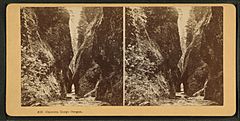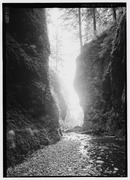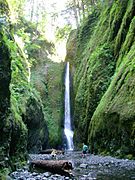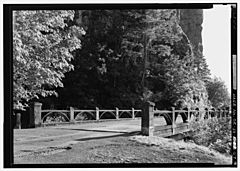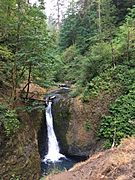Oneonta Gorge facts for kids
Quick facts for kids Lower Oneonta Falls |
|
|---|---|
| Oneonta Gorge Falls | |
 |
|
| Lua error in Module:Infobox_mapframe at line 185: attempt to index field 'wikibase' (a nil value). | |
| Location | 45°35′08″N 122°04′22″W / 45.58556°N 122.07278°W Multnomah County, Oregon, United States |
| Type | Plunge |
| Total height | 100 feet (30 m) |
| Number of drops | 1 |
| Middle Oneonta Falls | |
|---|---|
| Oneonta Falls | |
| Lua error in Module:Infobox_mapframe at line 185: attempt to index field 'wikibase' (a nil value). | |
| Location | 45°35′07″N 122°04′22″W / 45.58515°N 122.07279°W Multnomah County, Oregon, United States |
| Type | Horsetail |
| Total height | 24 feet (7.3 m) |
| Number of drops | 1 |
| Average flow rate |
150.0 cfs |
| Upper Oneonta Falls | |
|---|---|
| Oneonta Falls | |
| Lua error in Module:Infobox_mapframe at line 185: attempt to index field 'wikibase' (a nil value). | |
| Location | 45°34′56″N 122°04′22″W / 45.58235°N 122.07278°W Multnomah County, Oregon (no trail access) |
| Type | Plunge |
| Total height | 65 feet (20 m) |
| Number of drops | 1 |
| Average flow rate |
100.0 cfs |
| Triple Falls | |
|---|---|
| Lower Oneonta Falls, Oneonta Gorge Falls | |
| Lua error in Module:Infobox_mapframe at line 185: attempt to index field 'wikibase' (a nil value). | |
| Location | 45°34′43″N 122°04′20″W / 45.57861°N 122.07222°W Multnomah County, Oregon, United States |
| Type | Segmented |
| Total height | 64 feet (20 m) |
| Number of drops | 1 |
| Average flow rate |
200 cfs |
Oneonta Gorge is a scenic gorge located in the Columbia River Gorge area of the American state of Oregon. The U.S. Forest Service has designated it as a botanical area because of the unique aquatic and woodland plants that grow there. Exposed walls of 25-million-year-old (Miocene epoch) basalt are home to a wide variety of ferns, mosses, hepatics, and lichens, many of which grow only in the Columbia River Gorge. Oneonta Gorge with its 50 species of wildflowers, flowering shrubs and trees has been described as "one of the true dramatic chasms in the state."
There are four major waterfalls on Oneonta Creek as it runs through the gorge. Middle Oneonta Falls can be seen clearly from a footpath and is very often mistaken for the upper or lower falls. The lower gorge (a slot canyon) has been preserved as a natural habitat, so there is no boardwalk or footpath through it as such. Thus, Lower Oneonta Falls can only be seen by walking upstream from the creek's outlet at the Historic Columbia River Highway. To get to a vantage point where the entire lower falls is visible may require wading through water that in some places can be shoulders-deep, depending on the season and the relative amount of snow melt. The upper falls are about a mile upstream from the middle falls and require scrambling up the creek or climbing down a canyon wall to view. The fourth falls which is "Triple falls" can be viewed from several vantage points on the upper trails in the canyon.
The trail has issues due to natural as well as human impacts. In the late 1990s, the stream was partially occluded when three large boulders (the size of "pickup trucks") tumbled into the stream. Subsequently, a log jam has formed in the midst of the slot canyon. This has created a hazard for hikers, which led to a fatality in 2011.
As of November 2020[update] trails providing access to the waterfalls remain closed due to damage from the 2017 Eagle Creek Fire.
The Oneonta Gorge was first photographed by Carleton Eugene Watkins, a native of Oneonta, New York, who had traveled west in 1851 during the time of the California Gold Rush. Watkins named the Oneonta Falls after his hometown.
Gallery
-
Oneonta Gorge Creek Bridge on the Historic Columbia River Highway


